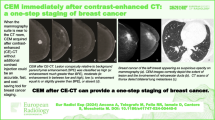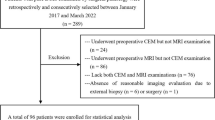Abstract
It is important to eliminate local residual cancer to avoid local recurrence after breast conserving treatment. Many efforts have been made to detect extensive intraductal components (EICs) and small invasive foci of breast cancer by diagnostic imaging including MRI and contrast-enhanced computed tomography (CE-CT). The abilities and limitations of CE-CT are reviewed in this article. The sensitivity of EIC detection by CE-CT ranges from 76% to 88%, and specificity from 79% to 89%. The sensitivity for detecting EIC and cancerous lesions were significantly higher for CE-CT than for US or MMG. The enhanced patterns of CE-CT demonstrating EIC and small invasive foci were classified into diffuse, spotty, linear and multiple types. The differences of the size of cancerous extension by CE-CT from the pathological EIC were within 2 cm in almost all cases. CE-CT is useful for visualizing EIC and small invasive foci of breast cancer.
Similar content being viewed by others
Abbreviations
- EIC:
-
Extensive intraductal component
- CE-CT:
-
Contrast-enhanced computed tomography
- vBCT:
-
Breast conserving treatment
- MMG:
-
Mammography
- US:
-
Ultrasonography
- MPR:
-
Multi planar reconstruction
- WSIC:
-
Wide-spread intraductal component
- LCIS:
-
Lobular carcinomain situ
- VNPI:
-
Van Nuys Prognostic Index
- MRI:
-
Magnetic resonance imaging
- H&E:
-
Hematoxylin and eosin stain
References
Fortin A, Larochelle M, Laverdiere J,et al: Local failure is responsible for the decrease in survival for patients with breast cancer treated with conservative surgery and postoperative radiotherapy.J Clin Oncol 17:101–109, 1999.
Schnitt SJ, Connolly JL, Khettry U,et al: Pathologic findings in re-excision of the primary site in breast cancer patients considered for treatment by primary radiation therapy.Cancer 59:675–681, 1987.
Ansher M, Jones P, Prosnitz L,et al: Local failure and margin status in early-stage breast carcinoma treated with conservation surgery and radiation therapy.Ann Surg 218:22–28, 1993.
Fisher B, Redmond C: Lumpectomy for breast cancer: an update of the NSABP experience.J Natl Cancer Inst Monogr 11:7, 1992.
Takashima S: Assessment of Mammographic diagnosis for the indication of breast-conserving therapy - special reference to extensive intraductal component and mammographic calcifications.Jpn J Breast Cancer 9:403–411, 1994 (in Japanese with English abstract).
Tsunoda-Shimazu H, Ueno E, Tohno E,et al: Ultra-sonographic evaluation for breast conservative therapy.Jpn J Breast Cancer 11:649–655, 1996 (in Japanese with English abstract).
Healey EA, Osteen RT, Schnitt SJ,et al: Can the clinical and mammographic findings at presentation predict the presence of an intensive intraductal component in early stage breast cancer?.Int J Radiat Oncol BiolPhys 17:1217–1221, 1989.
Endo T, Ichihara S, Aoyama H,et al: The indications for breast conserving surgery on mammography.Jpn J Breast Cancer 11:643–648, 1996 (in Japanese with English abstract).
Weinreb JC, Newstead G: MR imaging of the breast. [Review].Radiology 196:593–610, 1995.
Holland R, Veling SH, Mravunac M,et al: Histologic multifocality of Tis, T1-2 breast carcinomas.Cancer 56:979–990, 1985.
Boetes C, Mus RDM, Holland R,et al: Breast tumors: comparative accuracy of MR imaging relative to mammography and US for demonstrating extent.Radiology 197:74, 1995.
Kamio T, Kameoka S, Hamano K,et al: Indication for breast conservative surgery by ultrasonography.Jpn J Breast Cancer 11:656–664, 1996.
Muramatsu Y, Akiyama N, Hanai K: Medical exposure in lung cancer screening by helical computed tomography.Jpn J Radiol Technol 52:1–8, 1995.
Tsunoda HS, Ueno E, Tohno E,et al: Echogram of ductal spreading of breast carcinoma.Jpn J Med Ultrasonics 17:44–48, 1990 (in Japanese with English abstract).
Akashi-Tanaka S, Fukutomi T, Miyakawa K,et al: Diagnostic value of enhanced computed tomography in the detection of the widely spreading intraductal component of breast cancer: Case reports.Breast Cancer 4:29–32, 1997.
Akashi-Tanaka S, Fukutomi T, Miyakawa K,et al: Diagnostic value of contrast-enhanced computed tomography for diagnosing the intraductal component of breast cancer.Breast Cancer Res Treat 49:79–86, 1998.
Hiramatsu H, Enomoto K, Ikeda T,et al: Three-dimensional helical CT for treatment planning of breast cancer.Radiation Medicine 17:35–40, 1999.
Uematsu T, Sano M, Homma K: Helical CT of the breast.Jpn J Cancer Clin 46:593–599, 2000 (in Japanese with English abstract).
Folkman J, Watson K, Ingber D,et al: Induction of angiogenesis during the transition from hyperplasia to neoplasia.Nature 339:58–61, 1989.
Silverstein MJ, Lagios MD, Craig PH,et al: A prognostic index for ductal carcinoma in situ of the breast.Cancer 77:2267–74, 1996.
Silverstein MJ, Waisman JR, Gierson ED,et al: Radiation therapy for intraductal carcinoma.Arch Surg 126:424–428, 1991.
Adler DD, Wahl RL: New methods for imaging the breast: techniques, findings, and potential.Am J Radiol 164:19–30, 1995.
Weidner N, Folkman J, Pozza F,et al: Tumor angiogenesis: A new significant and independent prognostic indicator in early-stage breast carcinomas.J Natl Cancer Inst 84:1875–1887, 1992.
Revel D, Brasch R, Paajanen H: Gd-DTPA contrast enhancement and tissue differentiation in MR imaging of experimental breast carcinoma.Radiology 158:319–323, 1986.
Kurtzman SH, MacGillivray DC, Deckers PJ: Evolving strategies for the management of non-palpable breast abnormalities.Surg Oncol 4:1–14, 1995.
Flanagan F, Gilligan P, McInerney D,et al: MR mammography: a prepathologic predictor of breast tumor behavior? (abstr).Radiology 193:267, 1994.
Akashi-Tanaka S, Fukutomi T, Miyakawa K,et al: Clinical use of contrast-enhanced computed tomography for decision making in breast conserving surgery.Breast Cancer 4:280–284, 1997.
Author information
Authors and Affiliations
About this article
Cite this article
Akashi-Tanaka, S., Fukutomi, T., Miyakawa, K. et al. Contrast-enhanced computed tomography for diagnosing the intraductal component and small invasive foci of Breast Cancer. Breast Cancer 8, 10–15 (2001). https://doi.org/10.1007/BF02967473
Received:
Accepted:
Issue Date:
DOI: https://doi.org/10.1007/BF02967473




